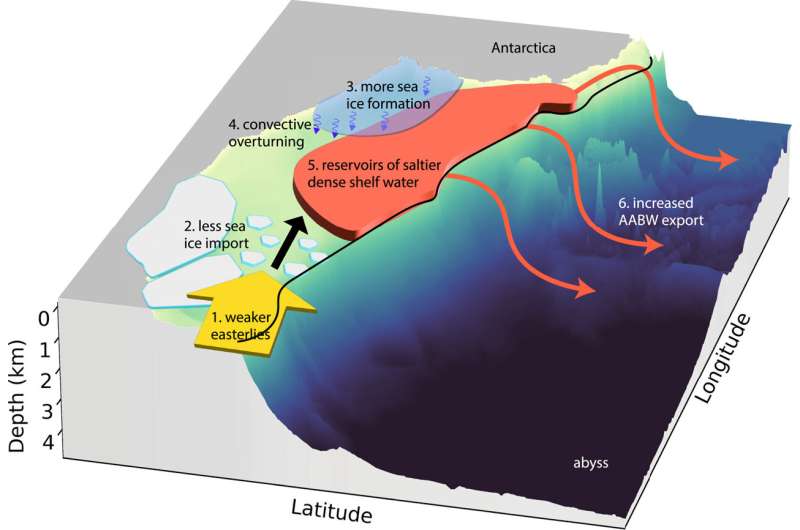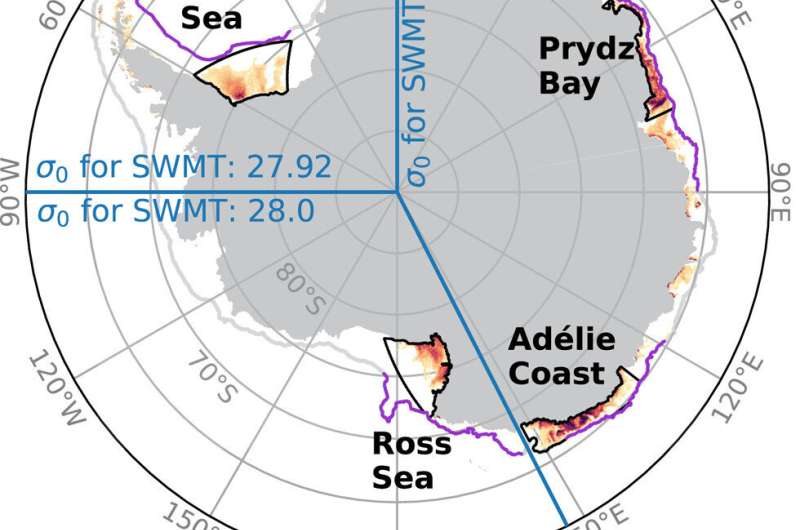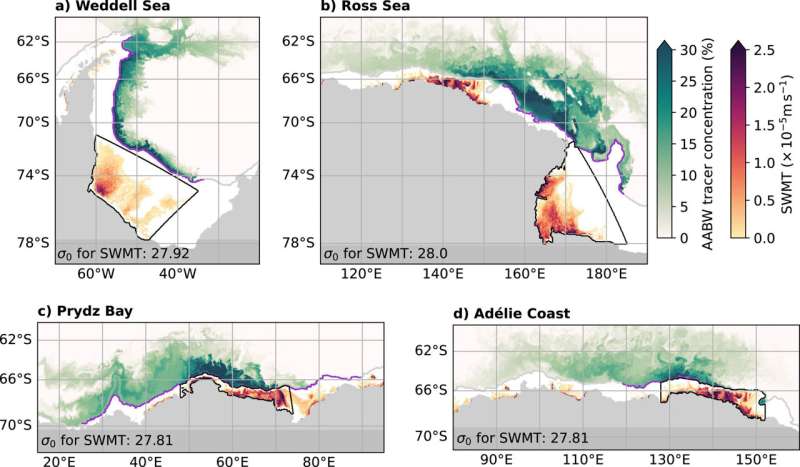June 28, 2023 feature
This article has been reviewed according to Science X's editorial process and policies. Editors have highlighted the following attributes while ensuring the content's credibility:
fact-checked
peer-reviewed publication
trusted source
proofread
Wind is a major driver of Antarctic deep water formation and the planet's ocean circulation, shows study

Earth's oceans are a complex system, and their interconnected nature has global implications. Around Antarctica, cold and dense waters form in the depths of the Southern Ocean. This is known as Antarctic Bottom Water (AABW). It comprises most of the deepest abyssal part of the ocean and approximately a third of the volume of the planet's marine environments. AABW has an important function in global circulation and the overturning patterns of the ocean, distributing heat, salt, carbon and nutrients northward into basins across the planet.
However, in recent decades AABW has become warmer, less saline and has declined in volume. This has consequences for ocean temperatures, ventilation and nutrient distribution to the surface, affecting marine ecosystems and the diverse organisms they support. It also affects the global climate and sea level rise, which impacts coastal communities.
AABW forms as a consequence of cold polar winds bringing sea ice into the region, the formation of which expels salt into the ocean (sea ice has a salinity of approximately 5‰, compared to 34.5‰ of the surrounding sea water). This salt concentrates in the ocean, making the sea water denser so that it sinks, drawing warmer and more buoyant offshore sea water to the area in a continuous cycle known as thermohaline circulation.
Researchers at the University of New South Wales, Australia, simulated the formation and migration of AABW over a 60-year period from four regions around Antarctica (the Weddell and Ross Seas, Prydz Bay and the Adélie Coast) based upon ocean-sea ice models. These models, reported in the Journal of Geophysical Research: Oceans, consider how changes in sea ice transport, melting of land-based ice and coastal winds impact AABW.

AABW reservoir export from the Weddell and Ross Seas can last up to two years, while for Prydz Bay and the Adélie Coast it is less than a year. The former scenario was found to have strong impacts on ocean circulation for up to a decade thereafter, while the latter results from the narrower East Antarctic shelf causing rapid export of Deep Sea Water (DSW) that prevents accumulation at depth.
A posited cause of this increased AABW formation from the Weddell and Ross Seas is weaker polar easterly winds, or even complete reversal to westerlies, which reduce the amount of sea ice being transported into the area, therefore leaving more open ocean. This creates polynyas, which are exposed to the full force of cold Antarctic air, thus encouraging sea ice formation at a much faster rate. Therefore, as sea ice grows, more salt is expelled into the oceans, increasing the amount available to form dense, saline AABW.
The Weddell Sea is the region with the highest formation level of AABW, with a maximum DSW flow rate of a colossal 4.9 million cubic meters per second down the continental shelf, which increases to 9.7 million m3/sec when AABW is then exported to the abyss of other ocean basins.
Surface water mass transformation estimates were used to calculate the rate at which surface waters were being forced to depth (a process known as downwelling) due to the difference in buoyancy resulting from temperature and salinity changes. This was aided by releasing dye-like tracers into the surface waters of the four regions, with different colors used for each. Previous research has found that tracers released in Prydz Bay indicate AABW merges westwards with that from the Weddell Sea and exits into the Atlantic Ocean and west Indian Ocean. Meanwhile, AABW from the Adélie Coast and Ross Sea merge for export into the Pacific Ocean.

Seasonality is also shown to be a factor in AABW formation and transport, with austral winter (occurring in the southern hemisphere June to August) seeing the greatest downwelling of surface waters, compared to none or very little in the summer.
During sea ice formation, brine is rejected into the ocean, increasing salinity and contributing to surface waters being transformed to depth. Within the Ross Sea, the researchers found that with greater sea ice formation, the flux of DSW into AABW increased, though this wasn't consistent across all four regions. When there are particularly strong downwelling events of dense and saline DSW, then the models show higher AABW export from the region for up to 10 years thereafter. This occurred in the Weddell Sea when strong surface water mass transport in 1962, 1980 and 1998 led to enhanced AABW formation during the 1960s, 1980s and from the late 1990s to mid 2000s.
While this research shows a correlation between wind and DSW (subsequently AABW) formation, the scientists do note that the effect of tides have not been included within the simulations, which are known to contribute to a reduction in AABW formation, this being a 10% and 30% decrease in the Weddell and Ross Seas respectively. It also does not account for seasonal variations in meltwater input, which freshens saline water, or ice shelf cavities. However, it does highlight the need for climate researchers to consider the effects of both short-term interannual variability and longer-term mechanisms to understand the implications of a warmer future reducing, or even collapsing, AABW formation.
More information: Christina Schmidt et al, Wind– and Sea‐Ice–Driven Interannual Variability of Antarctic Bottom Water Formation, Journal of Geophysical Research: Oceans (2023). DOI: 10.1029/2023JC019774
Journal information: Journal of Geophysical Research: Oceans
© 2023 Science X Network



















